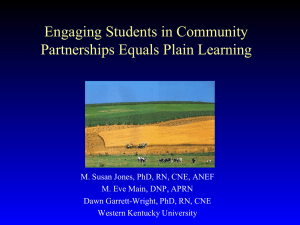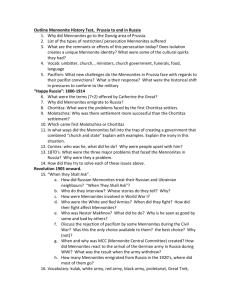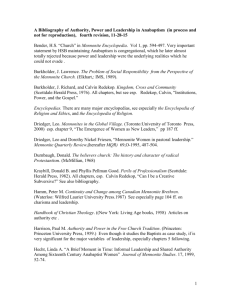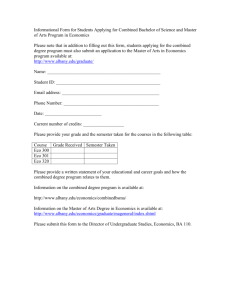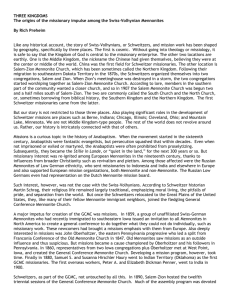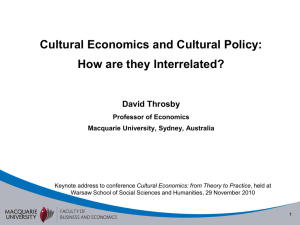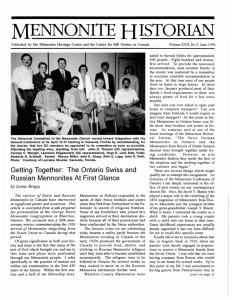15_0614ChadMartin - Community Mennonite Church of Lancaster
advertisement
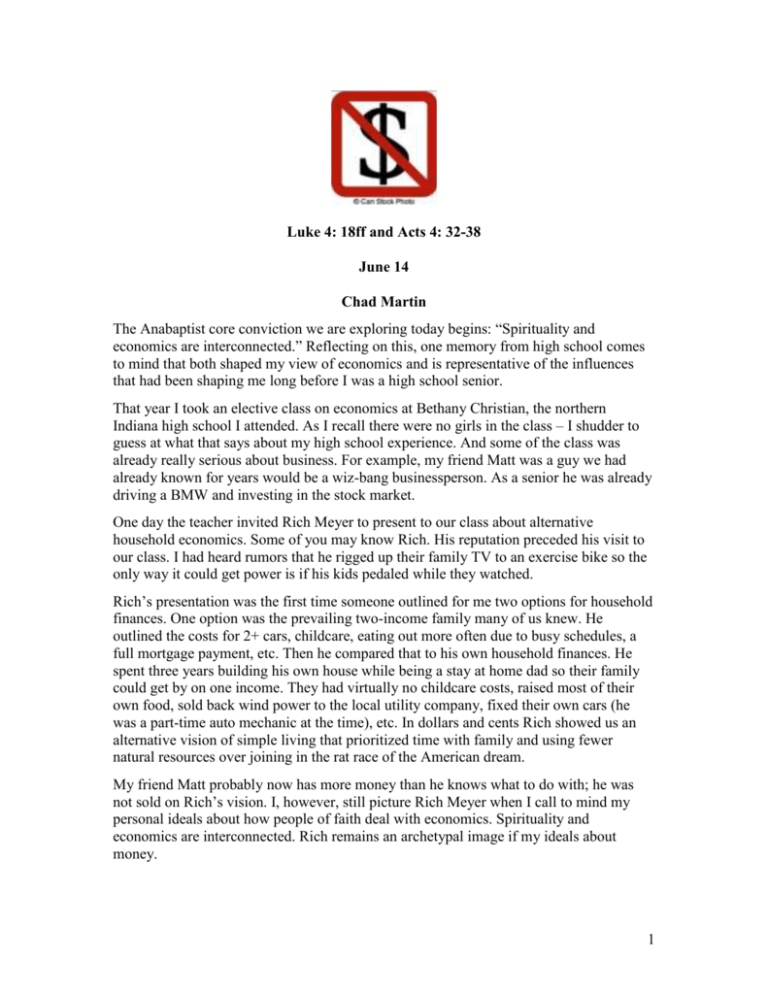
Luke 4: 18ff and Acts 4: 32-38 June 14 Chad Martin The Anabaptist core conviction we are exploring today begins: “Spirituality and economics are interconnected.” Reflecting on this, one memory from high school comes to mind that both shaped my view of economics and is representative of the influences that had been shaping me long before I was a high school senior. That year I took an elective class on economics at Bethany Christian, the northern Indiana high school I attended. As I recall there were no girls in the class – I shudder to guess at what that says about my high school experience. And some of the class was already really serious about business. For example, my friend Matt was a guy we had already known for years would be a wiz-bang businessperson. As a senior he was already driving a BMW and investing in the stock market. One day the teacher invited Rich Meyer to present to our class about alternative household economics. Some of you may know Rich. His reputation preceded his visit to our class. I had heard rumors that he rigged up their family TV to an exercise bike so the only way it could get power is if his kids pedaled while they watched. Rich’s presentation was the first time someone outlined for me two options for household finances. One option was the prevailing two-income family many of us knew. He outlined the costs for 2+ cars, childcare, eating out more often due to busy schedules, a full mortgage payment, etc. Then he compared that to his own household finances. He spent three years building his own house while being a stay at home dad so their family could get by on one income. They had virtually no childcare costs, raised most of their own food, sold back wind power to the local utility company, fixed their own cars (he was a part-time auto mechanic at the time), etc. In dollars and cents Rich showed us an alternative vision of simple living that prioritized time with family and using fewer natural resources over joining in the rat race of the American dream. My friend Matt probably now has more money than he knows what to do with; he was not sold on Rich’s vision. I, however, still picture Rich Meyer when I call to mind my personal ideals about how people of faith deal with economics. Spirituality and economics are interconnected. Rich remains an archetypal image if my ideals about money. 1 It would be too grandiose for me to try to argue that this image is the Mennonite way to think about economics. There are probably as many ways to think about Mennonite ideals about money as there are people in this room. So we could pick up any number of threads in service of this topic. This morning my goal is to give you a smattering of snapshots from Mennonite history that I think support the core conviction that Mennonites – that we – are “committed to finding ways of living simply, sharing generously, caring for creation and working for justice.” And then I’ll briefly invite us to contend with how these snapshots might inform our current economic situation. Peasant’s War In 1525, the same year that Conrad Grebel, George Blaurock and Felix Manz famously knelt down in the midst of a subversive church gathering and re-baptized each other – performing an act of heresy and likely treason – in that same year and the year leading up to it upwards of 100,000 commoners lost their lives in what has been known as the Peasant’s War.[1] This revolt was a popular uprising in Southern Germany where thousands of peasants, rural artisans and disenfranchised townsfolk took up arms in protest of the oppressive and corrupt feudal systems of their day. These commoners were striving for the end of serfdom practices, more say in the appointment of local religious leaders and greater access to common lands for grazing. Many of them also refused to make mandatory tithe payments to the church, in itself an illegal act of defiance against the all-encompassing power of church and state rolled into one. But it’s a misnomer to call this a war. Most often these were haphazard battles initiated by untrained and under-armed peasants who were slaughtered by imperial armies. One controversial figure represents the kind of leadership typical of various movements of this era. Thomas Muntzer was trained to be a theology teacher and was appointed by Martin Luther to be the preacher of a local South German church in 1520. Muntzer has been called a spiritualist, a mystic and an apocalyptic prophet. He became one of the theological fathers of the Peasant’s War. Muntzer believed that Christian salvation was an inner process of regeneration, a spiritual death and resurrection – as did many of the early Anabaptists. But he also believed that any worldly government that stood in the way of such salvific activity had forfeited God’s favor. It was up to the common person to rebel against such worldly powers. For most of the 20th-century Mennonite scholars tried to create ideological distance between the likes of Thomas Muntzer and his Anabaptist peers. Muntzer didn’t fit the narrative of a peace-loving movement. But more recent scholarship shows a deep ideological resonance and substantial collaboration between some of the Anabaptist leaders like Grebel and leaders of the Peasant War. For example, the Schleitheim Confession, written by Michael Sattler in 1527, borrows extensively from the manifesto that guided the violent rebels.[2] This is important for today’s topic because it reminds us how much the beginnings of the 2 Mennonite experience were as much a sociopolitical struggle for economic justice as it was a call to spiritual renewal. These were inseparable in 16th-century Europe. I think Thomas Muntzer, Conrad Grebel and Michael Sattler would say without a doubt that spirituality and economics are interconnected. This snapshot reminds us that the earliest days of the Mennonite experience were keenly focused on the strife of the peasant class. The Radical Reformers sought to create a church that would promote the wellbeing of the most economically disenfranchised. In some cases, they were willing to take up arms and literally fight to their deaths for this. Mennonites and Bolsheviks Next let’s look at a snapshot of the experience of Mennonites in Russia. I wonder how many of us had ancestors who migrated through Russia or have intimate knowledge of that part of Mennonite history? For some this is a close-to-home part of the story. For others it has been easy to forget how formative this part of the story has been for parts of the church. Mennonites began emigrating from parts of central Europe into Russia at the invitation of Catherine II in the 18th-century. As with many migrations in their history they were seeking good farmland and freedom from military participation.[3] For more than a century Mennonites prospered on mostly self-governed colonies where they ran their own schools, farms and businesses. For the most part this was a story of economic and church success. Mennonites were free to be themselves and thrived. Then the Bolshevik Revolution came. By that time some Mennonites had become exceptionally wealthy industrialists. At the same time the community remained so isolated that even few leaders spoke Russian. Suddenly these wealthy “foreigners” became targets of the revolution. At the same time the Ukraine, where many Mennonites had settled, was the frontline of the revolution. One Mennonite historian calls what followed a “reign of terror,” when hundreds of Mennonites were killed, countless villages were destroyed, and basically any atrocity of war you can imagine was perpetrated against Mennonite colonists.[4] This combined with a nationwide famine around 1920 pushed many of them into despair. Some Mennonites organized militias to protect the colonies. Eventually a coalition of church leaders traveled to North America pleading for financial support. The outcome was the formation of MCC, the Mennonite Central Committee. At the same time thousands of Mennonites escaped to Canada, the Western United States, Mexico and Paraguay. Once again, in this tragic chapter of history, we see how spirituality and economics are interconnected. The snapshot shows a picture of communities exceptionally adept at taking care of their own, a belief in peace that was at once noble and precarious, and the profound impact of compassion amid economic hardship. 3 More with Less This brings us well into the 20th-century of Mennonite life, and again at this point various pictures could inform this conversation. We could explore the legacy of mutual aid practices. We could add to the story Andrew told of the beginnings of Ten Thousand Villages. An important piece of the conversation is how conscientious objection led to several generations of young Mennonite men and women signing up to serve two years of alternative service that took them to all corners of the U.S. and deeply embedded an ethic of service. Thinking again of that memory I shared with you about Rich Meyer visiting my Economics class to talk about alternative visions of personal, or home, economics, my attention rests on the legacy of simple living in the Mennonite experience as epitomized in the More-with-Less Cookbook and the companion book Living More With Less, by Doris Janzen Longacre – mother of CMCL’s Cara Longacre Hurst. These books published in 1976 and 1980 could be seen as the pinnacle of a movement still embraced by many of us here at CMCL, and could be seen as the pragmatic outgrowth of generations of emphasis on service and the austere history as we have already seen in the first snapshots I shared this morning. As Mennonites in North America rebelled against plain dress as the primary expression of nonconformity and increasingly participated in service organizations that kept them in touch with the harsh realities of poverty in this country and around the world combined with the emerging environmental movement of the 60s and 70s and fuel shortages that provoked a liberal back-to-the-land movement all contributed to a theology of simple living. And it inspired a generation of liberal-leaning Christians beyond the bounds of the Mennonite church. We can see these various sociological factors in play in the five “life standards” developed in Longacre’s book: do justice; learn from the world community; nurture people; cherish the natural order; nonconform freely. Mennonite theologian Malinda Berry shows how these five standards, originally published as a “home economics” book are deeply rooted in a particularly theological perspective: These five standards chart a path of Christian discipleship that seriously and joyfully combines faith and action… Doris knew that being a Christian bathed in the waters of Anabaptism means living with what she called “holy frustration.”… [She] described this emotion by summing up the main question many of her contemporaries were asking in the face of the food and fuel crises of the 1970s: “ ‘We want to use less,’ they say. ‘How do we begin? How do we maintain motivation in our affluent society?’”… A more-with-less theology, then, is the way we verbalize the connections we make between God’s unified presence in the universe and our response to God as we live within the world.[5] And so these books, a cookbook and a home economics book, are chock full of stories about how to cook, how to eat and how to live daily life in a way that strives to honor the 4 planet and uses fewer resources. This may be the epitome of what it means to be Mennonite – encoding our theology amid pages of recipes and stories about daily life. They directly state that spirituality and economics are interconnected. Now What With all of this in mind, what does it mean to say today, in this time and place, that spirituality and economics are interconnected? I invite you to begin by looking at the map printed inside your bulletin. This is a map of recent census research broken down by neighborhoods charting the poverty rate in Lancaster City and surrounding communities. You can see that the warmer the color, the higher the percentage of residents living in poverty. The red areas are parts of this city where more than half of residents live below the poverty line. The means for a family of four, living with less than $25,000 a year.[6] The median income of households in Lancaster City is $33,000, and over 30% of households here now live in poverty.[7] Meanwhile, the average income at CMCL is $100,000. Of course not all of us are that well off. We have a wide spectrum of financial realities in this congregation. But when we come to church we are mostly interacting with households that have triple the income of the average neighbor to this congregation. Does that fact make you feel uncomfortable? I for one wish I didn’t know this dirty little secret that my household makes upwards of three or four times many of my neighbors. Today’s sermon title is an image, an image I have only ever seen on the side of a coffee mug here at CMCL. Of all the disowned mugs on the rack downstairs, this one is my favorite. It’s simple. Just a dollar sign with a red strike through it. I have no idea what it means or stands for. Does it mean the holder of the cup has no money? Does not want money? Doesn’t believe in money? I chuckle every time I use it. But deep down every time I pick it up I am reminded that it is foolish to pretend money is disconnected from church. Each time I pick it up I secretly wish someone would ask, “Hey, what do you think that cup means?” because I would love to get into more conversations each Sunday about how money and spirituality are interconnected. There is nothing fundamentally wrong with the gap between $33,000 and $100,000. Except, the wider the gap is the harder it is to truly understand and empathize across the differences. And the easier it is to slip into an assumption that our role as people of faith is to offer charity to those with less financial resources – to serve them as clients, patients and students. Yet the bible preaches good news to the poor, radical upheaval of the economic status quo and real relationship in a way that literally dissolves economic barriers by sharing all we have. This is what the bible calls us to. So what does it mean to say that spirituality and economics are interconnected here and now? I think it means that in one of the richest pieces of farmland in the country we cannot tolerate having 1 in 10 people live without enough food to eat.[8] 5 I think it means that in the oldest Mennonite community in the country we cannot tolerate 30% poverty rates. I think it means putting all the resources of our education and professional lives to work, the way many of the early Anabaptist leaders did, in solidarity with the economically marginalized folks in their midst. It means being willing to risk setting aside what we thought we knew, setting aside our own security, as so many of our ancestors did, to form communities of solidarity. To form communities that proclaim that when God provides there is enough. When God provides, there is enough for all. I think it means we must dare to dream with urgency and prophetic vision the way our ancestors dreamed. And we have to risk dreaming big, crazy dreams. Change means risky dreaming because half the dreams might look like crazy talk in hindsight. Some might look like crazy talk now. The only way to know the difference is to risk the dreaming. The times we live in are ripe for revolution in every way just as they were in 15th-century Germany and 20th-century Russia. What new vision will we dare to dream in the midst of such turmoil? What stories will our grandchildren be telling about how their ancestors believed that spirituality and economics are interconnected? [1] Historical details sourced from the Global Anabaptist Mennonite Encyclopedia Online, unless otherwise noted. Online at: http://gameo.org. [2] James M. Stayer, “Anabaptists and Future Anabaptists in the Peasant’s War,” in Mennonite Quarterly Review 62: 2 (April 1988), 112. [3] See Cornelius J. Dyck, An Introduction to Mennonite History, 3rd Edition (Scottdale, PA: Herald Press, 1993), 168-192. [4] Dyck, 186. [5] Malinda Elizabeth Berry, “The Five Life Standards: Theology and Household Code,” in Doris Janzen Longacre, Living More with Less, 30th Anniversary edition, revised and edited by Valerie Weaver-Zercher (Scottdale, PA: Herald Press, 2010), 35-6. [6] See https://www.healthcare.gov/glossary/federal-poverty-level-FPL/. Accessed June 14, 2015. [7] See http://quickfacts.census.gov/qfd/states/42/4241216.html. Accessed June 14, 2015. [8] “Let’s unite to feed the hungry of Lancaster County,” in LNP (June 22, 2015). Online 6 at: http://lancasteronline.com/opinion/editorials/let-s-unite-to-feed-the-hungry-oflancaster-county/article_0e2fc146-1096-11e5-bff0-b7990025bb42.html. Accessed June 14, 2015. Chad Martin chad@ communitymennonite.org Associate Pastor Community Mennonite Church of Lancaster 328 W. Orange St. Lancaster, PA 17603 (717) 392-7567 7
